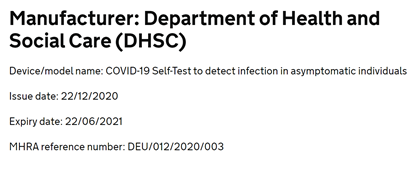
MHRA exceptional authorisation of Innova for asymptomatic individuals was issued on 22nd Dec.
This is a LIMITED approval, and the details of how and why it is LIMITED are important. It does not cover all current uses of INNOVA by Government
1/8
gov.uk/government/new…
This is a LIMITED approval, and the details of how and why it is LIMITED are important. It does not cover all current uses of INNOVA by Government
1/8
gov.uk/government/new…
Details here have been provided by the @MHRAgovuk by email. If any fact is incorrect here @DHSCgovuk @MHRAgovuk please let me know and I will change – it is a bit complicated and rather unusual.
2/8
2/8
First, approved test is called the “NHS Test and Trace COVID-19 Self-Test kit” - the LFT test in it is the INNOVA test.
Second, the test manufacturer is stated as “Department of Health and Social Care”, and not Innova.
This determines who has the duty of care and safety.
3/8
Second, the test manufacturer is stated as “Department of Health and Social Care”, and not Innova.
This determines who has the duty of care and safety.
3/8

MHRA confirmed details of the limited approval by email (their emphasis):
“ONLY allows for the test to be used to “find” positive cases.
MHRA HAVE NOT approved the test for use in a ‘test to enable’ scenario.”
4/8
“ONLY allows for the test to be used to “find” positive cases.
MHRA HAVE NOT approved the test for use in a ‘test to enable’ scenario.”
4/8
MHRA continue:
“as stated on our webpage, people should not act on a negative result and should continue to follow their local guidelines.”
“Any other use of the kit is outside of MHRA’s remit and at the manufacturer’s own risk.”
5/8
“as stated on our webpage, people should not act on a negative result and should continue to follow their local guidelines.”
“Any other use of the kit is outside of MHRA’s remit and at the manufacturer’s own risk.”
5/8
This indicates that MHRA experts have reviewed the evidence, and decided, like many others (WHO, CMO, SAGE, Royal College of Pathologists and summarised here bmj.com/content/371/bm…) that the inaccuracy in the test is too high for it to be approved as a “rule out” test.
6/8
6/8
However, @DHSCgov continues to use the test in “test to enable” scenarios – visiting in care homes, students safely travelling to and from University, school pupils remaining in class after being in exposed to a close contact, lorry drivers returning to France.
7/8
7/8
Any situation where people act because they have a negative result is a "test-to-enable" situation.
Given @MHRAgovuk has explicitly stated the test is not approved for this, the Government must now take notice (and not by tortous act/not act logic). Our health is at risk.
8/8
Given @MHRAgovuk has explicitly stated the test is not approved for this, the Government must now take notice (and not by tortous act/not act logic). Our health is at risk.
8/8
@threadreaderapp unroll
• • •
Missing some Tweet in this thread? You can try to
force a refresh




